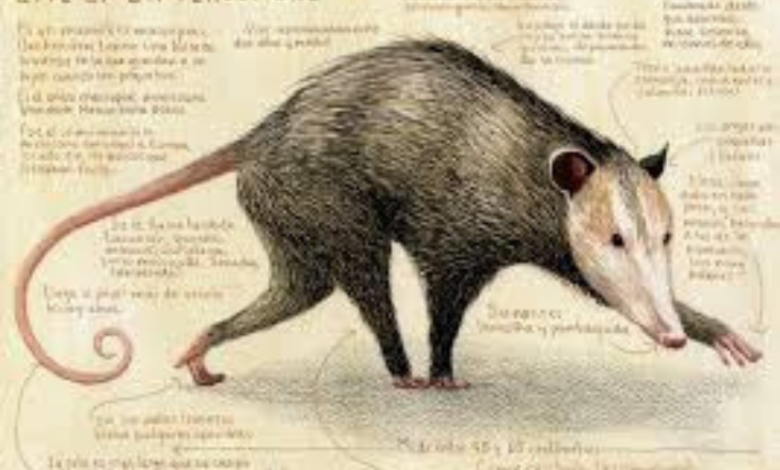Everything You Need to Know About the tñacuache

The tñacuache, known for its distinctive look and unique behavior, is a fascinating creature that captures the curiosity of many. In this comprehensive guide, we’ll dive into the world of the tñacuache, exploring its characteristics, habitat, behavior, and more. Whether you’re an animal enthusiast or simply curious, this article will provide you with all the essential details about this intriguing animal.
What is a Tñacuache?
The tñacuache, also known as the opossum, is a marsupial native to the Americas. Its scientific name is Didelphis marsupialis. Unlike other mammals, marsupials give birth to relatively undeveloped young that continue to develop outside the womb. The tñacuache is renowned for its adaptability and survival skills, making it a subject of interest for biologists and nature lovers alike.
Physical Characteristics
- Size and Build: Tñacuaches are medium-sized marsupials with a robust build. They typically measure between 40 to 60 cm (16 to 24 inches) in length, excluding the tail, which can be as long as their body. Their body weight ranges from 1.5 to 4.5 kg (3 to 10 lbs).
- Fur and Coloration: Their fur is generally a mix of gray and white, providing them with a distinct, mottled appearance. They also have a bare, prehensile tail that helps them balance and grip.
- Distinguishing Features: One of the most recognizable features of the tñacuache is its long, pointed snout and large, hairless ears. Their sharp, rodent-like teeth are adapted for their omnivorous diet.
Habitat and Distribution
- Native Regions: The tñacuache is native to Central and South America, with a range that extends from the southern United States down to northern Argentina. They are highly adaptable and can live in a variety of environments.
- Preferred Habitats: They thrive in forests, swamps, and even urban areas. Their ability to live in diverse habitats contributes to their survival across different regions.
- Climate Adaptations: Tñacuaches can withstand a range of temperatures, from tropical heat to cooler climates. They use their thick fur and fat reserves to stay warm in colder regions.
Diet and Feeding Habits
- Typical Diet: Tñacuaches are omnivorous, meaning they eat a wide range of foods including fruits, insects, small animals, and even carrion. Their diet is highly varied, which helps them adapt to different environments.
- Feeding Behavior: They are opportunistic feeders, often scavenging for food. Their excellent sense of smell and dexterous paws aid in locating and handling food.
- Interaction with Other Species: While they often scavenge, tñacuaches play a role in their ecosystem by controlling insect populations and spreading seeds through their feces.
Behavior and Social Structure
- Daily Activities: Tñacuaches are nocturnal creatures, meaning they are most active at night. They spend their days resting in nests or burrows and come out to forage and explore during the night.
- Social Groups and Hierarchies: Generally solitary animals, tñacuaches come together only for mating. They do not form complex social groups or hierarchies.
- Communication Methods: They communicate using a variety of vocalizations, including hisses, growls, and screeches. They also use body language, such as tail flicks and changes in posture, to express themselves.
Reproduction and Life Cycle
- Mating Season: Tñacuaches typically breed once or twice a year, depending on environmental conditions and availability of food.
- Gestation Period: The gestation period is quite short, lasting around 12 to 14 days. After birth, the tiny, undeveloped young crawl into the mother’s pouch to continue developing.
- Offspring Development: The young stay in the pouch for about two months before emerging. They are carried on the mother’s back until they are mature enough to fend for themselves.
Role in Ecosystem
- Impact on Plant Life: By consuming a variety of foods, including fruits and seeds, tñacuaches contribute to seed dispersal and help maintain plant diversity.
- Interaction with Other Animals: Tñacuaches are preyed upon by larger predators such as owls, coyotes, and raccoons. They also compete with other scavengers for food resources.
- Environmental Importance: Their scavenging behavior helps clean up the environment by consuming dead animals and organic waste, which can reduce the spread of disease.
Conservation Status
- Threats and Challenges: While tñacuaches are not currently listed as endangered, they face threats from habitat destruction, pollution, and road accidents.
- Conservation Efforts: Various conservation efforts focus on preserving their natural habitats and minimizing human-wildlife conflict. Awareness programs also aim to educate the public about their ecological importance.
- How to Help: You can support tñacuache conservation by participating in local wildlife protection initiatives, supporting habitat preservation projects, and reducing your ecological footprint.
Cultural Significance
- Role in Local Traditions: In some cultures, tñacuaches hold symbolic value and are featured in folklore and local traditions. They are often seen as symbols of adaptability and resilience.
- Symbolism and Folklore: Stories and myths about tñacuaches vary across cultures, reflecting their role in the natural world and human imagination.
Common Myths and Misconceptions
- Debunking Popular Myths: There are many myths about tñacuaches, including the belief that they are aggressive or carry diseases. In reality, tñacuaches are generally shy and non-aggressive.
- Facts vs. Fiction: Understanding the true nature of tñacuaches helps dispel misinformation and promotes a more accurate view of these fascinating animals.
How to Spot a Tñacuache
- Identifying Features: Look for their distinctive gray and white fur, long tail, and pointed snout. They are most active at night, so early evening or late night is the best time to observe them.
- Tips for Observation: Be quiet and patient, and use a flashlight to spot them in the dark. Observing from a distance ensures you don’t disturb their natural behavior.
Interesting Facts
- Unique Behaviors: Tñacuaches are known for their ability to play dead as a defense mechanism against predators. This behavior, known as “playing possum,” can be quite effective.
- Lesser-Known Details: They have an impressive immune system, which allows them to survive exposure to many bacteria and parasites that would be harmful to other animals.
Tñacuache in Popular Media
- Appearances in Film and TV: Tñacuaches have appeared in various films and television shows, often depicted as quirky and interesting characters.
- Influence on Art and Literature: Their unique traits and behaviors have inspired numerous works of art and literature, showcasing their role in human culture.
Conclusion
The tñacuache is a remarkable creature with a fascinating mix of physical traits, behaviors, and ecological roles. Understanding and appreciating this marsupial not only enriches our knowledge of wildlife but also underscores the importance of conserving diverse species and their habitats. By learning more about the tñacuache, we contribute to a greater awareness and appreciation of the natural world.
FAQs
- What is the best time to observe a Tñacuache in the wild?
The best time to observe a tñacuache is during the early evening or late at night when they are most active. - Are Tñacuaches dangerous to humans?
Tñacuaches are generally non-aggressive and pose minimal threat to humans. They may hiss or growl if threatened but usually prefer to avoid confrontation. - How can I contribute to Tñacuache conservation efforts?
You can help by supporting wildlife conservation organizations, participating in habitat preservation projects, and spreading awareness about their ecological importance. - What are some common predators of Tñacuaches?
Common predators include owls, coyotes, and larger mammals like raccoons. - Can Tñacuaches be kept as pets?
While tñacuaches are sometimes kept as pets, they require specific care and can be challenging to manage. It’s important to consider their natural needs and consult with experts before deciding.
